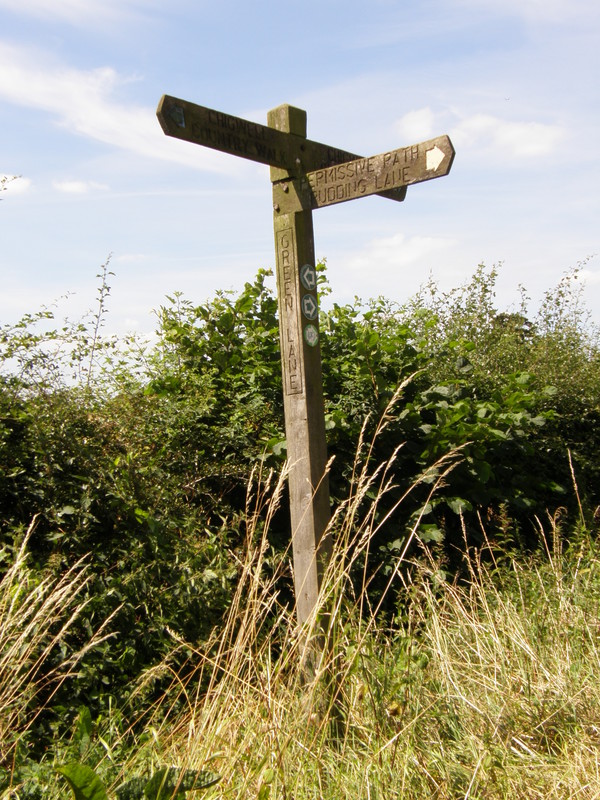
I was a little nervous about how today's walk was going to pan out, particularly as I was joined by my mate Charlie, who's a veteran of long-distance walks the world over. The first half of the Hainault loop from Leytonstone to Barkingside, which I walked a couple of days ago, had started off well but got a little ragged and slightly uninteresting towards the end, and I was a bit worried that Charlie would have to endure yet more endless backstreets of boring suburban housing, the sun cooking us in the treeless wasteland of zone 4... but in the event, this leg turned out to be a corker.
Indeed, zone 4 on the Hainault loop is surprisingly rural, particularly when compared with zone 4 on the rest of the network, and on a hot, sunny day like today, it's a dreamy walk through farmers' fields and posh housing that only switches back to suburbia when you rejoin the main Central line at Woodford. The eastern Central line has been a delight to walk, and this leg is no exception. I'll miss it when I'm back in the heat of the city...
Barkingside to Fairlop
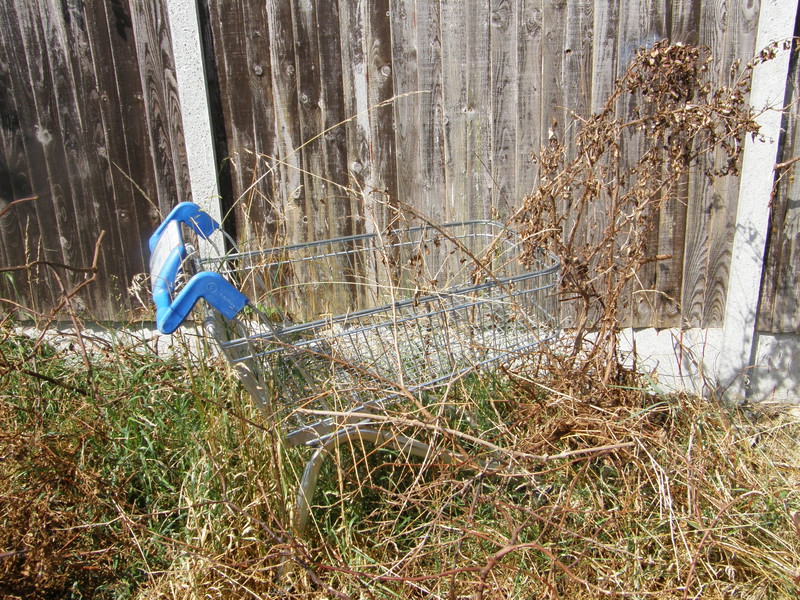
Before all the rural scenery kicks in, though, there's a short stretch through the suburbs of Barkingside, though it's possible to avoid the backstreets by taking the public footpath north along the side of the playing fields of King Solomon's High School. This looks good on paper, but the reality is a bit more earthy, as this is clearly where the locals come to dump their rubbish. It's a thin path, wedged between serious fencing on the right and the back gardens of the inhabitants of Heybridge Drive on the left, but that hasn't stopped someone dumping a shopping trolley on the side of the path, where it's fatally tangled up in the deep grass. How on earth did it get here? And what were they thinking? It makes you appreciate just how much effort goes into dumping shopping trolleys sometimes...
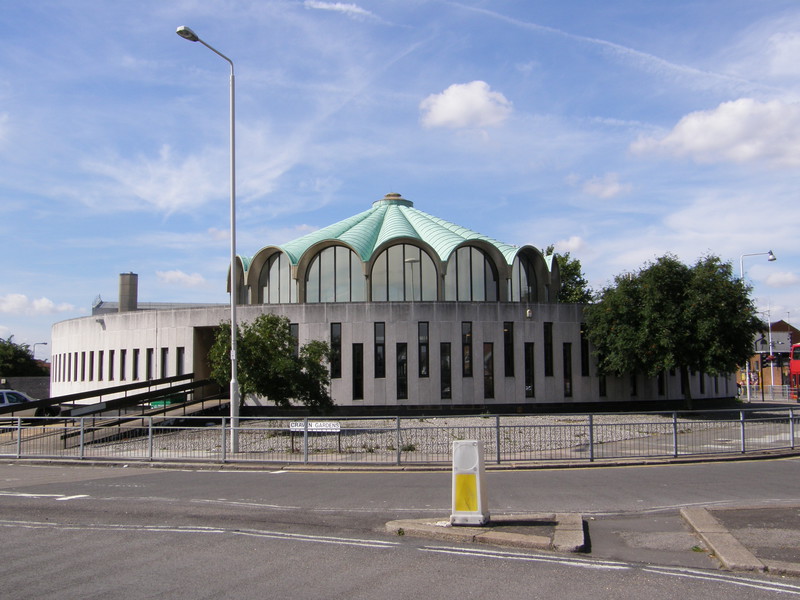
The neighbourhood of Fullwell Cross sits at the end of the path, and it's worth taking a short detour to the Fullwell Cross roundabout to see the Fullwell Cross public library. This distinctive round building has a really interesting green roof, making it look like an ultra-modern church; I liked it, anyway.
Fairlop station is a little walk east along Forest Road, and is tucked away from the road by the side of the Tube line. Along with its neighbouring stations, it was opened in 1903 as part of the Great Eastern Railway's Woodford to Ilford branch line, and the station hasn't changed much since then. From the outside it looks a little like a suburban house, and it's in very good condition for such a typical Edwardian station.
Fairlop to Hainault
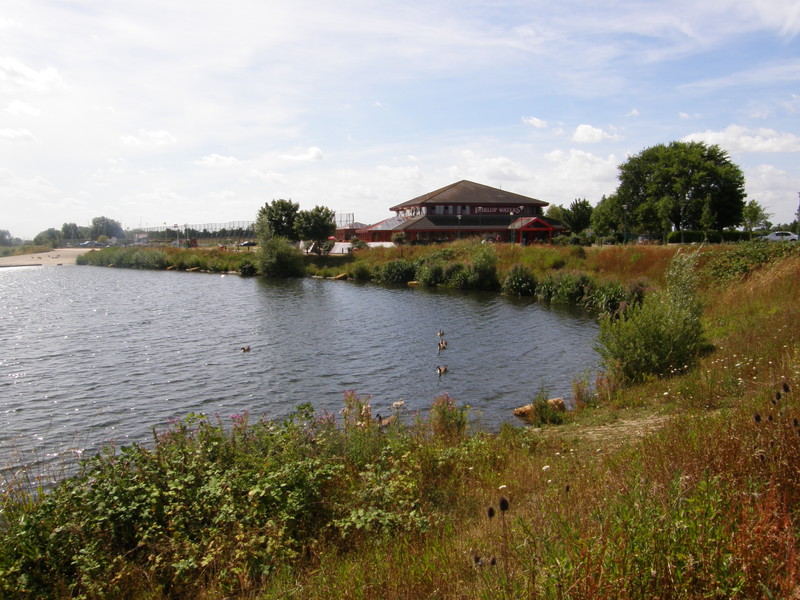
Further along Forest Road, past a farmhouse that dates from 1855, is Fairlop Waters, the largest country park and leisure facility in the London Borough of Redbridge. The complex consists of two golf courses, a driving range, a large boating lake, a conference centre and a restaurant, and while this might sound like the kind of place you'd bump into the photocopier sales conference from hell, it's actually a rather delightful place. The conference centre is pretty attractive and sits at the western edge of the lake, which is surrounded by bushy undergrowth and trees and makes for an enjoyable walk in the sun. The paths are wheelchair-friendly, so it's easy going, and on a hot day like today, the breeze coming across the lake is like manna from heaven.
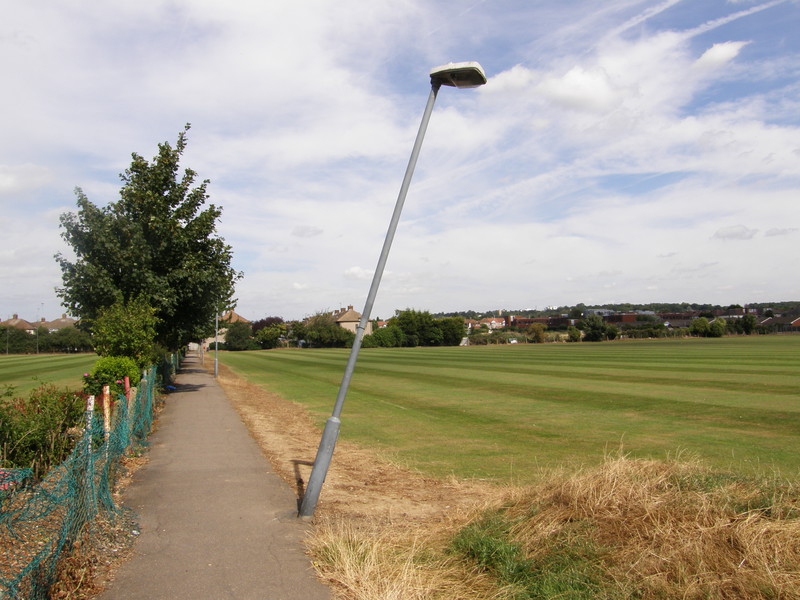
It's a bit of a shame to have to leave the country park and head back to the main road, but the station is on the other side of a small industrial estate and a huge expanse of sports fields. This is Fairlop Oaks playing fields, which hosts Powerleague five-a-side games and has an impressive collection of all-weather pitches alongside a larger grassy expanse to the north. On the other side of the footpath is the home of Ilford Wanderers Rugby Football Club – where large, yellow graffiti on the path helpfully points out that 'Liam is a cunt' – and then it's into the pebbledash suburbs of Hainault for a short walk to the station.
Hainault station is a fairly functional building, sitting at the base of the bridge carrying the line over New North Road. Just to the north of the station is the main Underground depot for the eastern Central line, and quite a few trains terminate here (when catching the Tube from Ealing Broadway, you either tend to catch an Epping train, or the Hainault via Newbury Park service, but they rarely go all the way through to Woodford). From here to Woodford, the Tube is a lot quieter, which is fitting because the real countryside isn't far off...
Hainault to Grange Hill
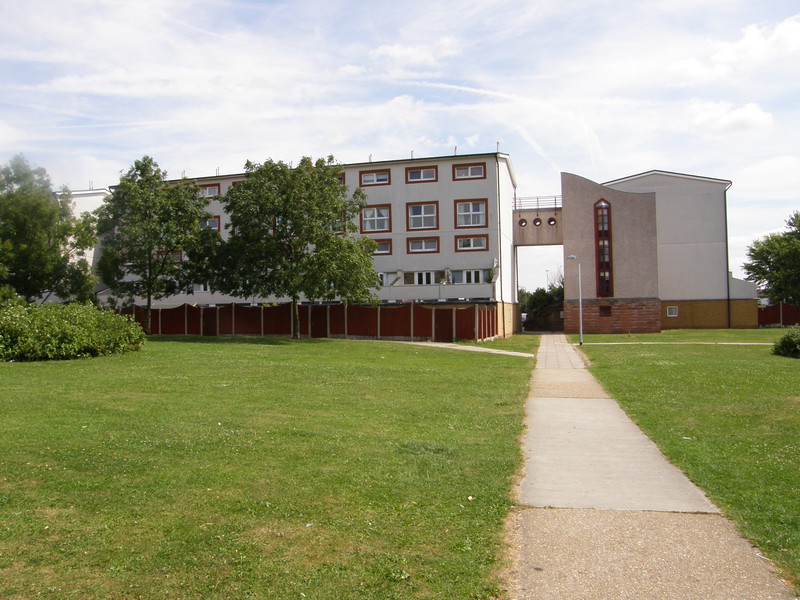
But before the rural edge of London kicks in, there's a short section through the Limes Farm Estate. Googling the estate name brings up a fairly sad picture, with residents feeling that the estate is out of control, one woman saying she received death threats when she caught youths in her garden, and the chairman of the Limes Farm Community Association saying, 'There is a great amount of bad feeling towards the police. They're appalling. They come over here frequently but it doesn't help. There's no way of stopping these kids from coming here. What can people do other than take the law into their own hands? I don't advise it, but I can see it happening.' It's scary stuff, made only scarier by the death of a 14-year-old schoolboy in after being stabbed in the back and head outside an unmanned police station; two boys, aged 13 and 14, were arrested on suspicion of his murder.
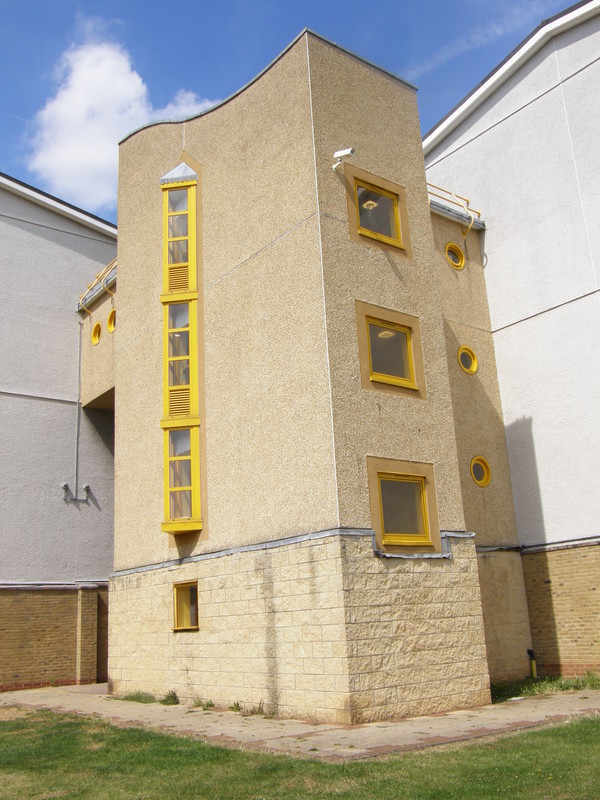
The amazing thing is that the estate is far from the nastiest I've seen, at least as far as the buildings are concerned. According to the council's website, the estate 'benefited from a major regeneration scheme in the early 1990s that improved the housing and removed many of the design issues associated with Council estates built in the 1960s. Alleyways and dark corridors were removed. New gardens and courtyards were built. Lighting was improved.' However, it seems the problem is down to youths from outside the area coming to the estate to cause trouble, and the result is a community in shock, with the police failing to sort it out. It's a shame, because both Charlie and I thought it was a nice place to live. There's a large grassy area with good views out to the centre of London (you can see Canary Wharf from the bench on the top of the hill), and the more modern blocks on either side of the green are really quite attractive. There isn't much litter, the grounds are well kept, and it keeps on improving as you head up the hill; indeed, the terraced houses to the side of the summit are lovely, sitting right next to the park on their own little side roads. Sometimes you look at an estate and it doesn't surprise you that it's anarchy inside; on the Limes Farm Estate, though, it's a bit baffling.
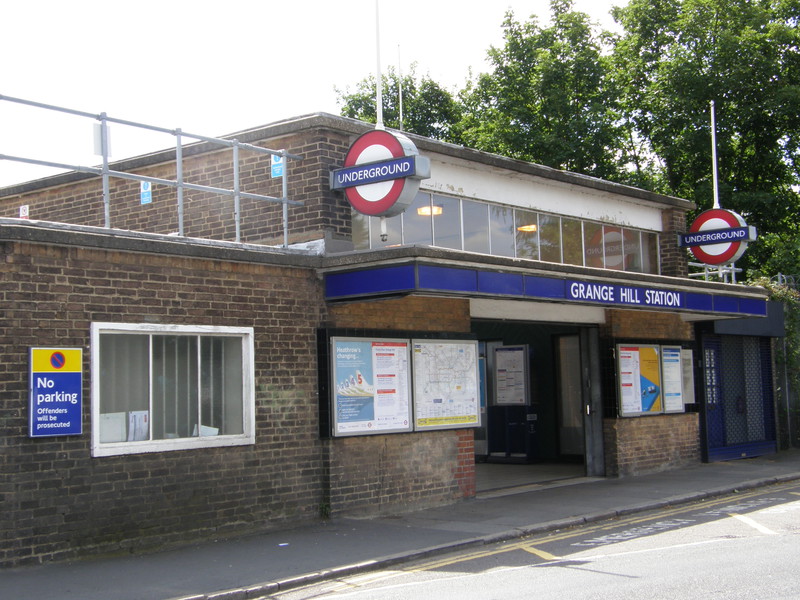
Out on Manor Road, to the north of the estate, it's a completely different story, and the houses are huge and generally rather pleasant. It's impossible to reconcile this part of town with the news headlines from the estate just a short walk downhill, because from this point onwards, this walk is a complete delight. There's a cute row of Mock Tudor houses opposite a small village green, and just past the shops is Grange Hill station, which isn't the original Edwardian station, but it's still far from ugly. The 1903 station was destroyed in 1944 by a German V1 flying bomb, but it was rebuilt in 1948 after the line was reopened as part of the Central line. Interestingly, in , this station became one of the first on the Tube network to open without a staffed ticket office; perhaps it took its cue from the police station down the hill...
Grange Hill to Chigwell
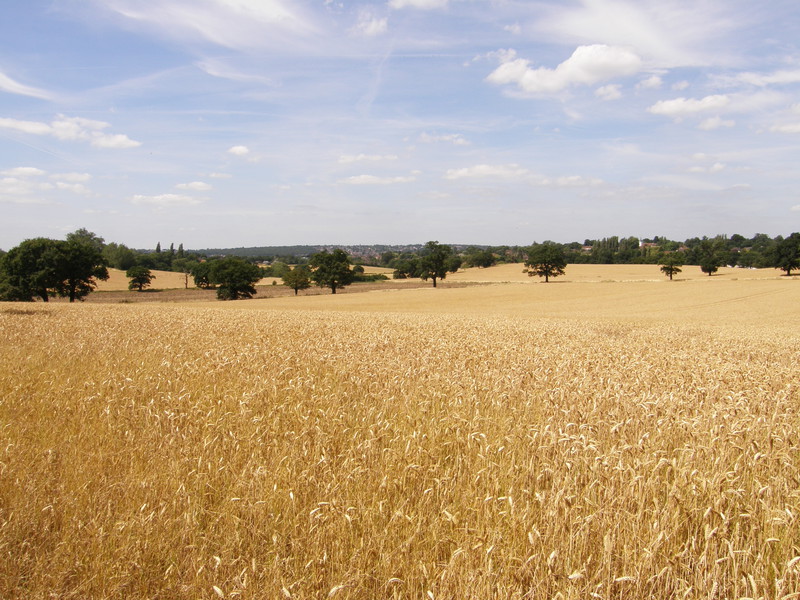
Just after the station there's a turning off the main road down to Chigwell Cemetery, but this isn't the path you want. We discovered this the hard way, wandering down to the cemetery and its handy toilet block, only to find that the right of way we thought we'd been following was on the other side of a fence. On attempt two, we managed to catch the right path through a small wooded area and out into some lovely farmers' fields that stretch all the way to the houses of Chigwell in the distance. This is cause for celebration, because this is now Essex, and rural Essex, too. We plonked ourselves on the edge of a field, in the shade of a tree, and enjoyed a leisurely lunch under the peaceful blue skies of the countryside, marvelling at the fact that this is still zone 4.
The walking continues in this vein, east through a cluster of houses on Vicarage Lane, and north along Green Lane, where we joined day 14 of the London Loop on its route towards Chigwell. When I walked this part of the Loop back in 2003, I noted that this was an area of 'wide-open spaces and large skies', and it's still the case, all the way back to Vicarage Lane and the northern fringes of Chigwell.
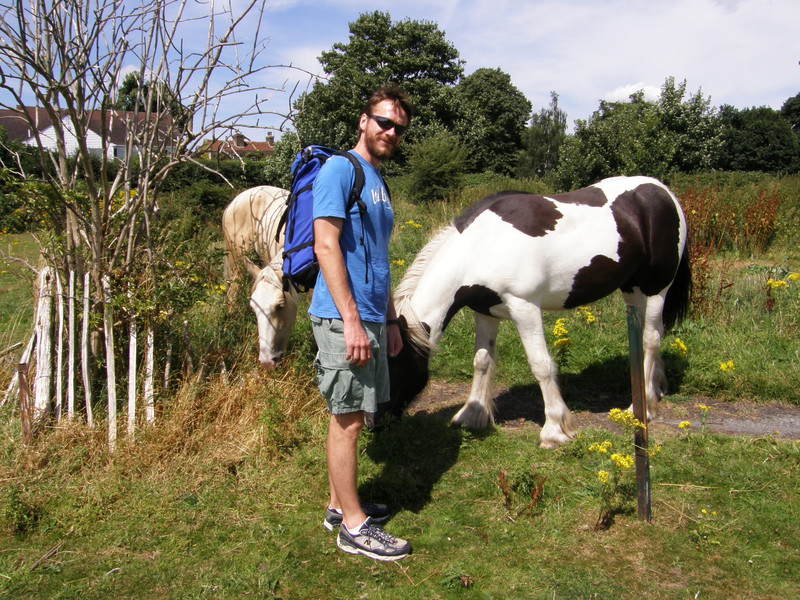
Chigwell is a very nice place, and after wandering through a field full of friendly horses, we came out on the High Road just north of St Mary's Church. There is a wonderful pub here, the Kings Head, which dates from 1547 and sports a real Tudor frontage, both on the roadside and in the lovely little beer garden out back. It sets the scene for an interesting walk down into Chigwell, though the real Tudor architecture soon morphs into Mock Tudor, which is where Chigwell starts to show its true colours. This is where the TV series Birds of a Feather was set, and that's just what it feels like. There is money here and the houses are clearly expensive, but lots of the houses sport the architectural equivalent of bling. White Doric columns are definitely in, though it's relatively sober this side of the Tube station; the best is yet to come, in the next section.
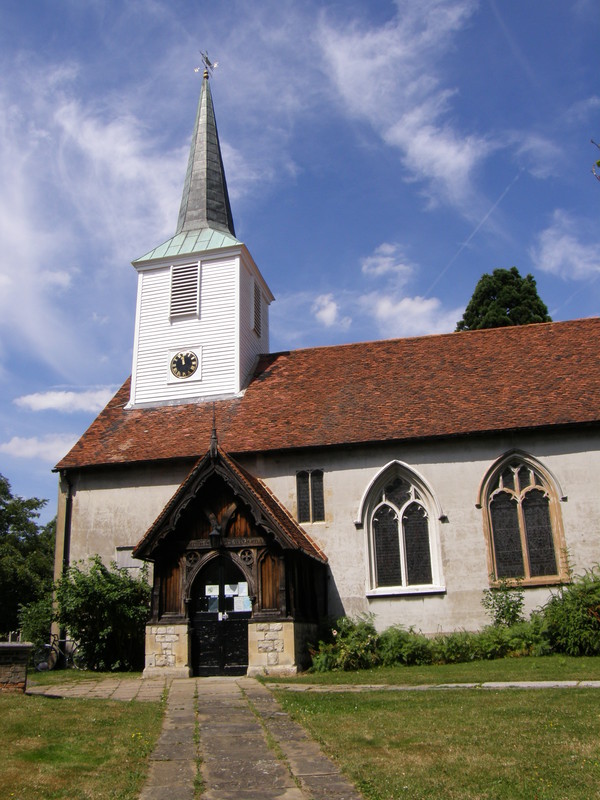
To celebrate our arrival in Essex proper, we stopped off for an ice cream and sat on the green in the middle of the village, watching the people go by. There's an interesting theme to the clothes round here: the men wear clothes that are at least one size too big, with baggy shorts and large T-shirts, while the women wear clothes that are at least one size too small, with tight tank tops struggling to keep their assets trapped inside, and shorts that ride up at the back in a severe colour clash between the pastel greens of the material and the day-glo orange of the spray-on sun tan that thrives round these parts.
As we sucked on our lollies, a group of four teenage girls arrived in the park to exercise their lungs, screeching unintelligible schoolgirl-speak at a group of kids on the other side of the park, though quite what they were screaming was a bit of a mystery. They were still yelling away when I wandered over to the bin to drop off our ice cream wrappers, but when the most boisterous girl spotted me wandering over, she dropped the volume and put on her best Lolita voice, rolling her eyes and fluttering her lashes.
'Welcome to Chigwell,' she said in her best faux tour-guide voice. 'We hope you enjoy your stay.'
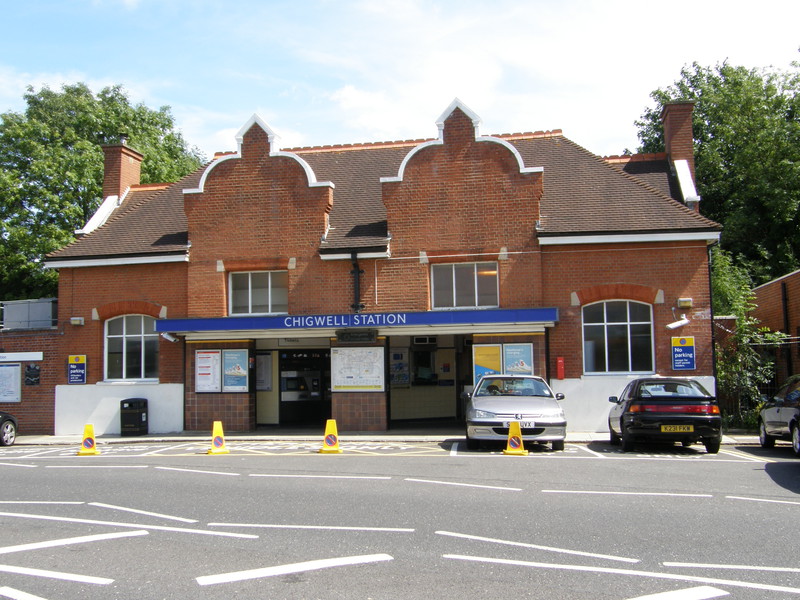
I laughed and said, 'Thank you very much,' smiling at them as they collapsed in teenage laughter, half of which was laughing with me, and half of which was laughing at me. It was quite charming, in a piss-taking kind of way, and I warmed to the place even more.
'Blimey,' said Charlie, as I returned to the fold. 'She'll do that to some poor bloke one day and he'll wake up a dad, the poor bastard.'
'Too right,' I said, and we headed for Chigwell station, which is a great little building. Like all the original stations between here and Newbury Park, it was designed by WN Ashbee for the Great Eastern Railway and opened in 1903, and it has a similar design to the original stations at Newbury Park and Grange Hill, neither of which are with us any more (Newbury Park was demolished to make way for the A12, and Grange Hill was, as already mentioned, bombed in the war). Oh, and the station brickwork has recently been repointed, and is now sun-tan orange. I kid you not.
Chigwell to Roding Valley
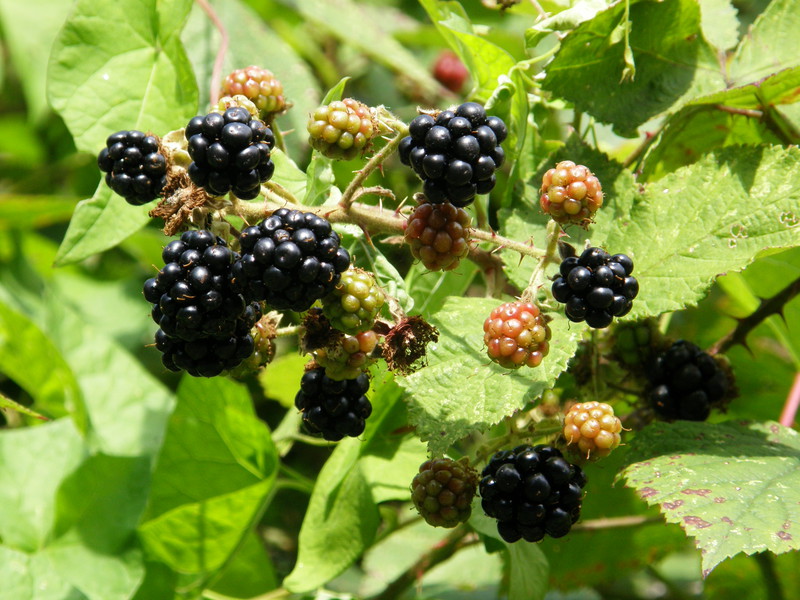
Past the station, the houses along the High Road get even larger and even crazier. Some push the boundaries of taste into a whole new area, while some are so bland (yet so obviously expensive) that you wonder how anyone could spend that much money but get so little imagination in return... but whatever the architecture, it's endlessly fascinating. Behind the houses on the left-hand side of the road is Chigwell Golf Course, which can only add to the sense of rural idyll that these large houses enjoy, and it's easy to see why Chigwell was lumped in with Loughton and Buckhurst Hill as the 'golden triangle' from the TV series Essex Wives, on account of the locals' hefty bank balances and ostentatious lifestyles.
It's no surprise to find that Chigwell is a popular residence for footballers, and turning off the High Road down Luxborough Lane takes you over the M11 and past Spurs Lodge, the club training ground of Tottenham Hotspur Football Club. This is a leafy part of the world, and it's strange to wander down a quiet lane with tasty blackberries hanging off the bushes, only to come to a huge inflated tent the size of a football pitch, followed by a set of gates with a cameraman and team of journalists standing outside, waiting to catch footage of the stars of the premiership leaving the training ground in their limos.
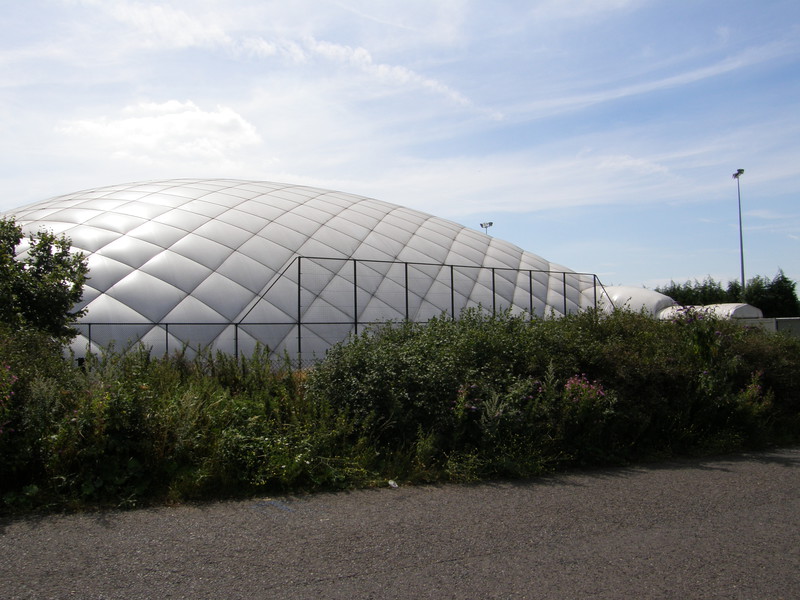
Luckily this nonsense doesn't carry through to the next section, where the Tube line crosses the River Roding on an impressive Edwardian viaduct and the path takes you into Loughton Rugby Ground and on through the suburbs on the border of Essex and the London Borough of Redbridge. Roding Valley station is a modest affair that was rebuilt in 1949; the original station had opened in 1936 with a small set of basic buildings, with the Woodford-bound side being nothing more than an all-wooden shelter. These days there's a bit more substance, and you can enter the station and cross the line without needing a ticket; as the station is unmanned, this is very convenient. Interestingly, Roding Valley is the least-used station on the entire London Underground network, though when you look at how the Hainault loop works, it's not that surprising, as to get here you either have to change at Woodford, or you have to follow the entire loop round through Hainault, and it's probably quicker just to hop on the bus.
Roding Valley to Woodford
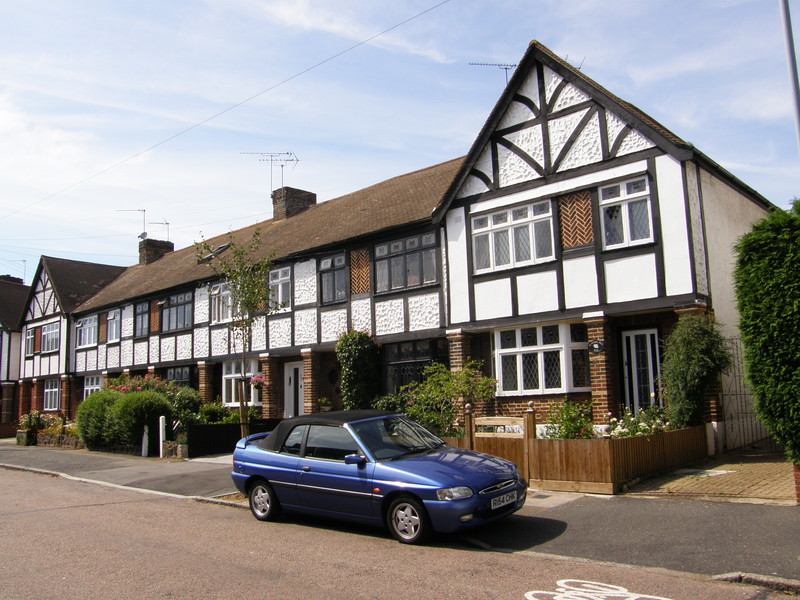
I'd originally planned to wander through Ray Park on the way to Woodford, but even though my A-Z showed a friendly looking path crossing the park, the chained fence and the 'Private Property' signs at the end of Durham Avenue rather stopped that plan in its tracks, so instead we took the direct route through the suburbs of northern Woodford instead. Near to Roding Valley station the suburbs are Mock Tudor heaven – good examples of the genre, too – but as you approach Woodford the Mock Tudor morphs into bungalows for a stretch, before turning into lovely Victorian and Edwardian terraces, though quite a few of these terraces have been sprayed with pebbledash, which is a shame. Still, it makes the bare-brick houses look even more beautiful, and happily they're in the majority.
Woodford station is past a small shopping area, and there's an entrance here, as well as a subway under the track to the entrance I visited on my walk from Leytonstone to Debden. And that brings me to the end of the Central line, and what a great line it is, too. It's urban, it's rural and it's delightful; I can't recommend it enough.